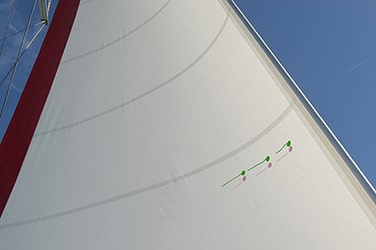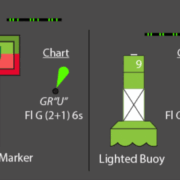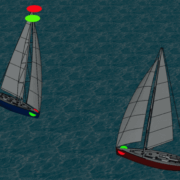
This article is an excerpt from NauticEd’s online FREE Basic Sail Trim Course, an interactive online sailing course for beginner to intermediate sailors to learn the basics of sail trim. Or if you want to learn more, upgrade to the Skipper Course Bundle to become a competent sailor!
You can learn to sail and improve your sailing with NauticEd, the international leader in sailing education.
Sailing at Night
Night Sailing Tips from an Experienced Delivery Captain
This article comes from our Micro-topic Podcast Series. Each week we invite a guest speaker to discuss one topic and one topic only.
This week we discuss Night Sailing Safety and Tips with Captain Ray McCormack who is a NauticEd American National Standards Instructor AND Delivery Captain. Ray’s specialty is delivering boats from Hawaii to the west coast of the USA and back. He also delivers up and down the west coast of North and South America as well as being a general captain for hire and sailng instructor anywhere in the world. Ray has a “world” of experience.
Below, listen to the Podcast, review a summary of keypoints, read a full summarized blog article, or view the whole transcript.
Listen to the Sailing at Night Podcast
Keypoints and Safety Tips for Sailing at Night
Guest Captain Ray McCormack shares his extensive experience and tips for staying safe while sailing through the night.
Use Proper Lighting
When sailing at night, it’s important to preserve your night vision. Ray recommends using headlamps with red, blue or green light options. White lights will ruin your night vision and make it harder to see lights in the distance after you turn them off. The US Navy has found green lights are best for maintaining night vision.
Establish Watch Schedules
Having an appropriate watch schedule is critical for getting through the night safely. Ray typically uses 3-hour shifts on his long Hawaii deliveries. This allows a 4-person crew to each get 9 hours of rest. But watches are affected by factors like cold, physical exertion from driving the boat or trimming sails, etc. The schedule needs to be flexible.
Maintain a Diligent Watch
It’s important to keep a diligent watch, especially in high-traffic areas. Having two or three people on deck can help manage busy situations. Avoid things that make you drowsy on watch like alcohol. Starlink internet access makes it easy to stay awake and engaged and get work done during night watches.
Know Other Vessel Light Identifications
Understand how to read lights on other vessels. This can tell you the direction of travel and the type of vessel from afar.
Use Proper Equipment
Quality binoculars are essential for night sailing. While night vision goggles are an expensive option, 7×50 binoculars with a compass and light work well. An AIS transponder and radar reflectors help your boat be seen by other vessels.
Plan Your Route
Establish your route and plans for the night before it gets dark. Review weather briefings, scrub the route for any hazards, and make sure the crew is briefed.
Prepare Creature Comforts
Small details make a big difference on overnight sails. Boil water before dark and store it in an airpot for easy coffee, cocoa, oatmeal and soups through the night. Prepare gallon zip lock bags of snacks for each crew member to munch on during their shifts.
Safety First
Make sure the crew is briefed on what to do if challenges like traffic or weather changes arise during the night. Require life jackets, tethers and jack lines be used at night. Make a policy for crew to stay in the cockpit until others arrive to help. Always use extra caution moving around at night – keep “one hand for yourself, one hand for the boat.”
Avoid Unnecessary Risks
Entering unfamiliar harbors or crossing bars for the first time at night adds major risk. It’s often prudent to wait for daybreak, by either slowing down or anchoring outside the harbor if possible.
Savor the Experience
The spectacular sunrises and sunsets you witness on overnight passages will be some of your most treasured memories from the experience. Having a rotating shift schedule allows all crew members to enjoy the beauty of twilight from the water.
In summary, with proper planning, equipment and precautions, sailing through the night can be a safe and memorable experience. Seasoned captains like Ray McCormick have developed best practices that maximize safety and minimize risk during overnight passages.
Podcast Summary
Master Sailing at Night: Night Sailing Tips and Techniques from Captain Ray McCormack
Sailing through the night can be an exhilarating and rewarding experience, but it also comes with its own set of challenges and risks. To help you navigate the dark waters safely and confidently, we’ve enlisted the expertise of Captain Ray McCormack, a seasoned sailor with extensive experience in long-distance deliveries, particularly from the West Coast to Hawaii.
In this comprehensive guide, Captain McCormack shares his invaluable insights and techniques for mastering the art of night sailing. Whether you’re a seasoned sailor or a novice, these tips will help you prepare for and execute a safe and enjoyable overnight voyage.
Key Night Sailing Points:
- Use headlamps with red, green, or blue light to maintain night vision
- Establish an appropriate watch schedule and stick to it
- Keep a diligent watch, especially in high-traffic areas
- Identify other vessel’s lights
- Use binoculars and consider investing in night vision equipment
- Plan your route and discuss potential challenges with your crew before nightfall
- Prepare snacks and boil water for easy access to food and hot beverages during the night
- Use jacklines and tethers to ensure crew safety on deck
Maintaining Night Vision:
Captain McCormack emphasizes the importance of preserving your night vision. He recommends using headlamps with red, green, or blue light, as these colors help maintain your ability to see in the dark. Avoid using white light, as it can temporarily impair your night vision and make it difficult to see lights in the distance.
Establishing a Watch Schedule:
To ensure a safe and efficient passage through the night, it’s crucial to establish an appropriate watch schedule. Captain McCormack typically uses a 3-hour watch system, which allows each crew member to get adequate rest. However, the watch schedule may need to be adjusted based on factors such as weather conditions and crew fatigue.
Keeping a Diligent Watch:
Maintaining a vigilant watch is essential, particularly in high-traffic areas. Having multiple crew members on deck can help ensure that potential hazards are spotted and addressed quickly. To stay alert during your watch, Captain McCormack suggests consuming caffeine and snacks, as well as using tools like a watchmate timer to prevent falling asleep.
Know How to Identify Other Vessels:
Familiarize yourself with the lights exhibited by different types of vessels to determine their direction of travel and vessel type. – Keep a vessel identification chart readily available while on watch for quick reference.
Understanding the light patterns can help you identify if a vessel is anchored, underway, or engaged in specific activities like fishing or towing.
Common light configurations include:
- Masthead light (white) and sidelights (red and green) indicate a power-driven vessel underway.
- Sidelights without a masthead light suggest a sailing vessel.
- A single white light may indicate an anchored vessel or a vessel under 7 meters in length.
- Fishing vessels often display additional lights, such as green over white or red over white.
Navigation and Planning:
Before nightfall, it’s important to plan your route and discuss potential challenges with your crew. This includes reviewing the weather forecast, identifying any navigation marks or hazards along the way, and ensuring that your course is properly plotted on the chart. Captain McCormack also recommends “scrubbing the route,” which involves verifying that you’re on track and making any necessary adjustments.
Jacklines and Tethers:
One of the most critical aspects of night sailing safety is the use of jacklines and tethers. Jacklines are lengths of webbing or rope that run along the deck of the boat, providing attachment points for tethers. Tethers, which are typically made of webbing with a failing thread, connect the crew member’s life jacket to the jackline, preventing them from falling overboard.
- Jacklines should be installed along the length of the boat, allowing crew members to move safely from the cockpit to the bow and back
- Tethers should have two hooks, enabling the crew member to remain attached to the jackline at all times while moving about the boat
- Crew members should wear life jackets and tethers whenever they are on deck, especially at night
- Establish a policy that crew members should stay in the cockpit unless accompanied by another crew member when leaving to perform tasks on deck
~
Captain Ray McCormack emphasizes the importance of preparation, communication, and adherence to safety protocols when sailing at night. By establishing clear policies regarding life jackets, tethers, and jacklines, and ensuring that crew members understand their roles and responsibilities, you can significantly reduce the risks associated with night sailing.
One of the most critical aspects of night sailing is maintaining a proper watch schedule. Captain McCormack typically employs a 3-hour watch system, which allows crew members sufficient time to rest while ensuring continuous coverage. However, he also stresses the importance of flexibility, adapting the schedule as needed based on factors such as weather conditions and crew fatigue. To combat fatigue during night watches, Captain McCormack recommends keeping a supply of snacks and beverages readily available. Boiling water before nightfall ensures that crew members can easily prepare coffee, tea, or instant meals without disrupting their watch.
Engaging in light activity, such as reading or completing simple tasks, can also help maintain alertness.
In addition to personal safety measures, effective communication is crucial when sailing at night. Crew members should be familiar with the vessel’s navigation equipment, including radar and AIS transponders, and understand how to use them to identify and communicate with other vessels in the area.
By establishing clear intentions with other boats, such as agreeing on a crossing plan, crews can minimize the risk of collisions and ensure a safer passage. When entering unfamiliar harbors or crossing bars at night, Captain McCormack advises exercising caution and, if possible, waiting for daybreak. If conditions require proceeding, he recommends slowing down, running a ley line offshore, or anchoring outside the harbor until visibility improves.
Despite the challenges, night sailing also offers unique rewards, such as the opportunity to witness breathtaking sunrises and sunsets. Captain McCormack encourages his crew members to take the time to appreciate these moments, as they often become the most memorable aspects of a long-distance voyage.
By following these night sailing techniques and prioritizing safety, communication, and preparedness, you can ensure a successful and enjoyable overnight passage. Remember to always stay vigilant, adapt to changing conditions, and work together as a crew to make the most of your night sailing experience.
Podcast Transcript
(NOTE: this is essentially the original transcript except the “you know’s” and “Um’s” and have been taken out and the language cleaned up to flow more evenly)
Grant Headifen: Alright, well, welcome everybody to the NauticEd micro-topic podcast series where each week we cover small topics in short 10-15 minute episodes allowing us to learn a lot of things very quickly. Today, I have Captain Ray McCormack on the phone with me. He’s in Vancouver, Washington and has done many yacht deliveries, with his favorite being from the West Coast to Hawaii, which takes several weeks. He’s certainly qualified to talk about night sailing. Ray, welcome to the show.
Ray McCormack: Thank you, Grant. I look forward to sharing my knowledge and passion about being on the water. Today’s topic is night sailing techniques, and I have a list of bullet points to cover.
Grant Headifen: Let’s dive right in and knock them out. I’ve looked over the list, and it looks fantastic. Go for it.
Ray McCormack: One of the first things I tell my crew on deliveries is to get a headlamp with both red and white light options. There are also alternative colors like blue and green that people use for maintaining night vision. Using these colors in the evening helps maintain your night vision, whereas using a white light can temporarily impair your ability to see lights in the distance when you turn it off.
Grant Headifen: So, these headlamps have little buttons that allow you to change colors, right?
Ray McCormack: That’s correct. My headlamp only has white and red options, but I know the US Navy has done studies and they’re using green now for night vision.
Grant Headifen: Interesting. What’s next on the list?
Ray McCormack: Establishing an appropriate watch schedule is critical for getting through the night. On our deliveries, we typically use 3 to 6-hour shifts, with 3 hours being the most common. With a crew of four and 3-hour shifts, everybody gets 9 hours of rest. Factors like getting cold or having to work hard driving the boat or trimming sails can affect the watch schedule, so it’s never set in stone.
I usually give each person a number – I’m number one, my first mate is two, and the other crew members are three and four. My watch might be from 8 to 11 pm, but that may slide depending on the situation. The next evening, I might take the 9 pm to midnight shift. After my watch, the next person would serve their 3 hours, and so on. In the daytime, we use a “freewatch” system where if you can stay up and let others nap, that’s what you should do.
Grant Headifen: I did a 3-day, 3-night trip in the Caribbean once, and I had a rotating schedule where I had the 9 pm to midnight watch the first night, then midnight to 3 am the second night, and 3 to 6 am the third night. It was nice to have a varying schedule and get to see both a sunrise and sunset. Is that what you’d call a structured rotating schedule?
Ray McCormack: Yes, a rotating watch schedule. After we’ve gotten out of the trade winds on my Hawaii deliveries, we’ll set up a rotating schedule like that for the evenings.
Grant Headifen: Alright, let’s move on to the next point.
Ray McCormack: Keeping a diligent watch is super important, particularly in high-traffic areas. Sometimes having two or three people on deck helps in those situations, and that can be structured into the watch schedule.
Grant Headifen: What about falling asleep on watch? Sometimes you can’t help it when you’re tired and it’s pretty boring up there. What can you do to prevent that?
Ray McCormack: Coffee and snacks can help. Caffeine and a little bit of sugar can keep you going.
Grant Headifen: I’ve heard about using an egg timer or “watch mate” that’s set for a short period, and if you don’t reset it, an alarm goes off. Have you used those?
Ray McCormack: I’m familiar with watch mates and know they’re used on some commercial boats, but I don’t use them on my deliveries. In the first couple of days, some crew might have trouble sleeping due to the excitement and the big waves and wind in the trade winds, but they usually start sleeping well off-watch pretty quickly. That’s the key to not falling asleep on watch.
Grant Headifen: Right, and things like alcohol are a bad idea if you’re trying to stay awake on watch.
Ray McCormack: Definitely. On the Hawaii deliveries, I might hide a couple of bottles of alcohol for a halfway party, but that’s dependent on the weather. We’ll only break them out if we’re expecting a fairly calm day.
Grant Headifen: One thing that really helps me is if the boat has Starlink. I can sit up top with my laptop and actually get some work done at 2 in the morning. Highly recommend Starlink for keeping your crew awake, even if just for that purpose.
Ray McCormack: The next bullet point is about having good binoculars. As a delivery captain, I always bring a pair of quality binoculars with me on every boat.
Grant Headifen: Do you use night vision binoculars? I know those can be quite expensive.
Ray McCormack: Right, they are expensive. If you have the resources to get them, that’s great, but I don’t carry night vision binoculars. Mine are typical 7×50 binoculars with a compass and a light.
Having an established route and plan for the evening before nightfall is a good idea. It gets the whole crew together to discuss the evening’s weather, verify the route, and make sure things like water have been boiled. That’s something you’ve mentioned a couple of times now – what’s the deal with boiling water?
Ray McCormack: On my deliveries, I typically set up an airpot, which is a pump pot for dispensing coffee and water. They’re glass-lined, and we’ll put the airpot in the sink or lash it to something. We boil water and fill it before the evening so people can have coffee, cocoa, hot soup, or oatmeal throughout the night.
Grant Headifen: Or even things like noodles, right?
Ray McCormack: Yep, exactly.
Grant Headifen: You also mentioned “scrubbing the route” earlier. What does that mean?
Ray McCormack: Scrubbing the route means verifying that we’re on track and looking ahead on the chart for any navigation marks, reefs, or other hazards. Sometimes a route will go right over a navigation mark, and you don’t want to run into those. You should typically be offshore of them.
On my deliveries, I’ll often put some green 2-inch painter’s tape on the bulkhead with a black marker, so when we have a course, we can mark down the autopilot heading. That way, if you turn the boat in the evening, you know what heading to go back to.
Grant Headifen: That’s smart. You mentioned to me once about a crew member who forgot to account for an overnight wind change. What happened there?
Ray McCormack: That was two years ago in November on a delivery from Hawaii to Vancouver. I had a discussion with the whole crew in the cockpit about an expected 180-degree wind shift overnight. We had the boat set up on apparent wind mode on the autopilot, but one of the crew members decided not to wake me when the wind shifted. The boat’s course over ground changed significantly.
I got up in the middle of the night to use the bathroom and saw the sun rising on the wrong side of the boat, but I was so tired I didn’t really process it. The next morning, I realized we had only made 4 miles towards our destination.
Grant Headifen: [Laughs] Oh man, that’s rough. Okay, what’s the next bullet point?
Ray McCormack: We make sure everybody has a one-gallon zip bag with their name on it, filled with snacks like chips, granola bars, and candy. They take that up on watch so they have something to eat without having to go below.
Grant Headifen: Because a little food can help keep you awake, right? Not too much, but just munching a bit.
Ray McCormack: Exactly, a little sugar and caffeine can help.
Grant Headifen: What else do you have on the list?
Ray McCormack: It’s good to talk ahead of time about potential issues that could develop overnight, like traffic. That’s one reason we carry an AIS transponder and radar reflectors up on the rig, so we can be seen. I’m a big fan of communicating with other boats and establishing crossing intentions. We practice hailing other vessels on the VHF, switching to another channel, and agreeing on whether we’ll cross their bow or stern.
Grant Headifen: AIS is a super important tool for sailing at night. We’ll have to cover that in more depth in another episode, but teaching your crew how to use it properly is key.
Ray McCormack: Absolutely. The next bullet point is about using radar and AIS transponders for added safety at night. It’s critical to use those tools in addition to the chartplotter. It’s worth noting that if you have functional radar on board and get into a collision, the US Coast Guard will fine you because you’re required to use it.
Another policy I put in place, usually in the float plan and discussed with the crew ahead of time, is the use of life jackets, tethers, and jack lines, and the rule about staying in the cockpit until others come up from the cabin to help.
Grant Headifen: Can you explain jack lines and tethers a bit more?
Ray McCormack: A jack line is typically a piece of webbing that runs along the deck, either around the perimeter of the boat or from the cockpit to the mast or bow. The tether is a shorter piece of webbing with a snap hook on each end, one connecting to the jack line and the other to your life jacket. The tether usually has a quick-release shackle and an indicator flag that deploys if it’s put under load, letting you know it needs to be replaced.
Some tethers have a dual hook setup, with a short and a long tether, so you can move along the jack line and always stay clipped in by connecting the second hook before disconnecting the first.
Grant Headifen: That’s really important for staying safe, especially at night or in rough conditions. Okay, keep going.
Ray McCormack: The policy about staying in the cockpit is something I make clear to my crew. I usually sleep in the quarter berth, so they know they can pound on the deck with a winch handle or change the engine RPMs to wake me up if needed. I’ll generally be the one to go up on deck to address any issues, even overnight.
Grant Headifen: Because you’ve got the experience and you don’t want to send a green crew member up on deck in the middle of the night, especially in big waves.
Ray McCormack: Exactly. It’s all about being extra careful at night. We have a saying: “one hand for yourself, one hand for the boat.” Keep your weight low and crawl on deck if you need to. Be mindful when moving around the boat, and always use your headlamp to keep your hands free.
Grant Headifen: Better to crawl than to fall, for sure. What about going up and down the companionway?
Ray McCormack: Always face the ladder and use the handholds. Don’t go down facing away from the steps, because you’re likely to slip and fall, and that’s how people end up with cracked ribs. On a Hawaii delivery, that’s really bad news, especially if you’re a thousand miles from land.
Grant Headifen: Face the stairs, toes in, got it. What else?
Ray McCormack: Entering harbors and crossing bars for the first time at night is riskier than doing it in daylight. Sometimes it’s best to wait for daybreak, either by slowing down or anchoring out if you’re in a bay.
On the Columbia River bar, which is like my playground after hundreds of crossings, there’s nowhere to anchor, so we either slow down or do circles until the conditions improve. I rarely have to do circles, though. We usually just slow down.
Grant Headifen: So if you’re looking at your projected arrival time and it’s, say, 5 am, you might decide that’s too early and adjust your speed or sail plan to delay your arrival until daylight.
Ray McCormack: Right. Sometimes I’ll run an offshore ley line, calculating how long it’ll take if we sail out, jibe, and then sail back in. It adds a bit of extra distance but it’s safer and more comfortable.
Grant Headifen: Safety first, always. What’s the last item on your list?
Ray McCormack: Sunsets and sunrises. On my Hawaii deliveries, I tell people that the one thing they’ll always remember is the incredible sunsets and sunrises we get to see. They’re absolutely beautiful, and I have so many photos of them.
Grant Headifen: That’s one great thing about a rotating watch schedule – everybody gets a chance to see the sunset or sunrise from a different part of the night.
Ray McCormack: Definitely. Like I said, on the Hawaii trips we wait until we’re out of the trade winds to start the rotating schedule so we don’t add any extra complexity. As the wind starts to back and we ease the sails, it gets really nice out there.
Grant Headifen: Ray, thanks so much for all these tips on night sailing. They’re not just tips, but more like must-do’s for safety. Anything else to add before we wrap up?
Ray McCormack: No, I think that covers it. Thank you for the opportunity to share this information.
Grant Headifen: It’s been great having you. Thanks for joining me today, Ray. Happy sailing, and stay safe out there.
###
Learn Basic Sail Trim for FREE...
A FREE 1-2 hour course that teaches how to work with sails to get your boat moving. The free Basic Sail Trim Course is for any aspiring sailor as well as experienced sailors wanting to learn more. Or, consider upgrading to the Skipper Course Bundle to become a fully competent skipper!











